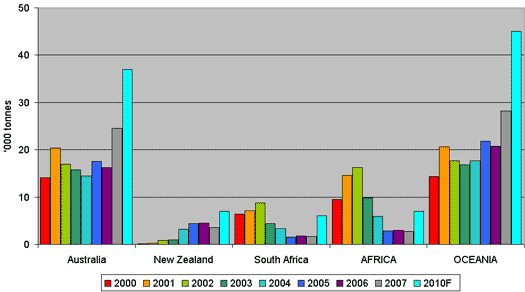



GLOBAL POULTRY TRENDS - Little Chicken Meat Trade Generally in Africa & Oceania
In general, countries in Africa and Oceania do not trade significant volumes of chicken meat, writes Terry Evans in this latest article in the series Global Poultry Trends exclusively for ThePoultrySite. Notable exceptions are South Africa, which now imports around 15 per cent of its requirements and exports from Australia and New Zealand, which have increased rapidly in recent years.Africa is not a major chicken meat-exporting region: the total transported has declined from a peak of 16,200 tonnes in 2002 to around 2,700 tonnes between in 2007. The forecast for the current year is put at just 7,000 tonnes. The decline simply mirrors what has happened to the region's only significant exporter, South Africa. Here, sales slipped from around a peak of almost 8,800 tonnes in 2002 to less than 1,800 tonnes in 2007. A recovery to around 6,000 tonnes is envisaged for 2010 (table 1), accounting for almost 86 per cent of the regional total.

In contrast, between 2000 and 2007, chicken meat imports into Africa more than doubled from 260,000 tonnes to 666,000 tonnes with South Africa, Angola, and to a lesser extent, Ghana being the main recipients (tables 1 and 2).
The way that imports have increased from just over 50,000 tonnes in 2001 to more than 210,000 tonnes in 2007 must be a major concern for South African broiler growers. As a result, imports have become a significant portion of the broiler market, representing approximately 14 per cent of total broiler consumption in 2008, rising to 15 per cent in 2009. In 2009, South Africa's poultry meat imports rose by 10,100 tonnes to exceed 231,000 tonnes, with broiler meat accounting for some 89 per cent of this total. Turkey products made up most of the balance. In 2009, nearly 72 per cent of imports originated in Brazil, reflecting exchange rate dynamics, competitive advantages in terms of climate, feed costs and economies of scale and, in the view of the Southern African Poultry Association (SAPA), government support. Angola and Canada were the next leading suppliers accounting for almost 14 per cent and five per cent of the total, respectively.
A further concern is that, while this year is expected to witness an increase in imports towards a quarter of a million tonnes, by 2018, another projection foresees them rising to around half a million tonnes.
In 2009, sub-Saharan Africa ranked seventh by value and sixth by volume among the regions taking American poultry meat. Indeed, since 2005, US exports to this region have expanded by 51 per cent. The total last year amounted to almost 171,000 tonnes, with Angola the leading purchaser taking 78,000 tonnes, followed by Ghana with nearly 23,000 tonnes. Approximately 88 per cent of this trade was in leg portions.
In 2010, Africa is expected to import between 886,000 and 1,067,000 tonnes of poultry meat.
Clearly Oceania is not a major player in the chicken meat trade. Between 2003 and 2007, annual imports amounted to just over 30,000 tonnes, with the bulk being purchased by French Polynesia (table 5).
However, this area is a little more active in the export business, total sales having doubled since 2000 to reach 28,000 tonnes in 2007. Australia increased its involvement from 14,000 tonnes to almost 25,000 tonnes in this period. New Zealand has managed to expand its sales from virtually nothing to an estimated 7,000 tonnes this year.
Forecasts on the trade in poultry meat put Oceania's exports this year at around 45,000 tonnes with at least 37,000 tonnes being shipped from Australia, while on the buying side at least 50,000 tonnes could be imported.

Further Reading
| - | You can view other articles in our series Global Poultry Trends by clicking here. |
September 2010













